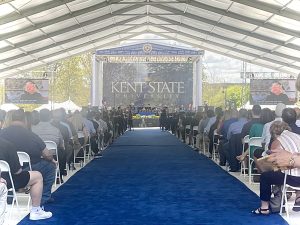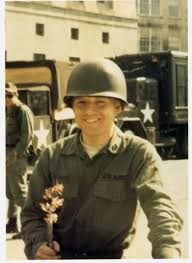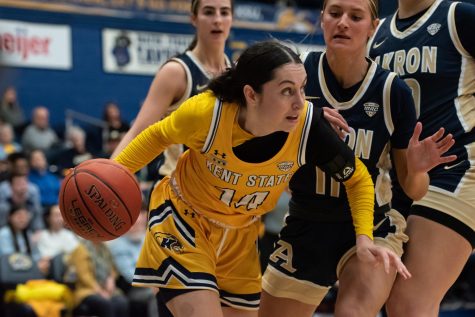The thrill of victory, the agony of injury
November 30, 1999
Athletes sacrifice bodies for sports
Story by: Josh Johnston
Julian Edelman saw the play break down and ran.
“The pursuit from behind came, and I was in between a slide and not sliding, and I put my arm down like this,” the Kent State quarterback said as he rolled up the sleeve of his Under Armour shirt and stuck his right arm out, revealing an ugly, 6-inch scar on his forearm.
“The guy just came and ‘bah!’ His shoulder, or I think it was his thigh, with my weight on the ground, took my arm out.”
Rachel Bennett came off a high ball screen and drove down the lane during practice two weeks before the start of the Kent State women’s basketball team’s 2006-2007 season.
“I went to extend up, and my knee buckled,” the junior guard said. “My (medial collateral ligament) blew first, and then everything else blew.”
Bennett dropped to the floor and stayed there.
Heather Dixon tore the meniscus in her knee during an early-season tournament her freshman year. She didn’t find out until Thanksgiving – a week after the last volleyball match of the season. Dixon played only one more year after that. A promising career cut short.
For some college athletes, competition is their life. It’s why they wake up to lift weights at 5:30 in the morning before classes. It’s why they miss both school and holidays to play in tournaments across the country. It’s who they are. But an injury takes that away from an athlete.
“They’re not able to do what they want to do, what gives them pleasure and what is part of their identity,” said Glen Conley, Kent State volleyball coach. “I think a lot of athletes view themselves as an athlete.
“When you’re really involved in something, you have the tendency to say that’s who I am. So my identity’s wrapped up in being an athlete. When you see yourself as no longer an athlete, well, then I don’t have an identity. Who am I?”
The injury
“When it came, it came hard, and it hurt.”
It’s been more than a year since Edelman’s arm was broken against Bowling Green at home. Already nursing a torn ligament in his left knee, the quarterback’s second injury ended his junior season early and abruptly.
Injuries are just part of the game, Edelman said.
“Football’s probably the last barbaric sport – along with rugby and hockey,” he said. “You’re signing yourself up for this. My parents said I picked the wrong sport, but my heart was with this game. It’s something you’ve got to live with.”
Not all injuries happen in an instant, though. Some gradually build up over time, hiding just beneath the surface and not causing enough pain for an athlete to take necessary precautions – at least not until it’s too late.
“We see that constantly from track and field,” athletic trainer Pamela Long said. “They just think it’s just a little bit of pain. They don’t want to let the coach know that they’re hurt, and they feel like they’re not performing because the coach will tell them to suck it up.”
Kelly Gephart was one of those athletes. The junior runner for both cross country and track said she ignored pain from stress fractures (tiny cracks in her bones) during her freshman year.
“Runners go through a lot of minor injuries, and so the pain, I thought, was probably temporary,” she said. “I didn’t really go about it the right way because I should have spoken up when I started having the pain, and I didn’t speak up.
“(The pain) was definitely gradual, but when it came, it came hard, and it hurt.”
The stress fractures sidelined Gephart for two months.
The rehab
“I had to learn how to throw again.”
Bennett’s knee injury in her sophomore year wasn’t her first. She had torn her left knee during high school. But with a torn MCL and meniscus to go along with her torn anterior cruciate ligament, Bennett’s second injury was easily worse.
“It was hard for me mentally because I didn’t understand why it had to begin,” she said. “I had so much stress with school, and I wanted to play, and I was out. “Probably my biggest person to thank throughout that whole thing … (was) Michael Heichel, our athletic trainer. He knows how to push people. He helped me get through that hump a lot. He was one of my biggest reasons to get through that.”
Every sports team at Kent State has athletic trainers following it, from daily practices to away games. Still, trainers cannot spot every injury, Long said. They have to rely on athletes coming to them, which doesn’t always happen.
“You always get that ‘I just thought it’d go away,'” Long said. “(Athletes) come into you two weeks later, and something that could have been shin splints turns into a stress fracture, and now they’re out six-to-eight weeks.”
Long, who works primarily with the track and field team, said some athletes are in rehab year-round. With cross country, indoor track and then outdoor track, their seasons virtually never end. “Some kids are just prone to getting chronic injuries over and over again,” she said. “I mean, some of these kids have been running track and field since they were 6. So I tell them, ‘Your knees are like that of a 6-year-old. They’re just so worn down.’ I have them coming in more for maintenance than anything.”
Life without the practices and competitions is difficult for some athletes, Gephart said. “It’s something that’s a part of your life all the time, and then it’s gone for eight weeks,” Gephart said.
“A lot of runners, when they’re not running, when they don’t have the sport, get kind of moody. I was probably the worst person to be around ever during my time off.”
While injured, Edelman watched three different quarterbacks take over his role.
“It was very frustrating,” he said. “You watch someone else just come in and play your position. It’s tough for an athlete mentally. Then you have to wait the whole next year to prepare and you’ve got to go out and prove why you were the starter. It’s hard, but you’ve just got to work and go with it.”
With the injury to his throwing arm, Edelman had to start over from square one. A day after the Bowling Green game, he was in surgery. Doctors put a plate and six screws in his arm. For the next couple months, Edelman worked just to get the flexibility in his arm back. Gradually, he started throwing again.
“I had to throw a lot over the summer (to) try to get my timing back because my rotation was all different,” he said. “I had to learn how to throw again.”
The return
“I play my heart out.” Bennett returned in the 2007-08 season to a team short on players. With only two other guards on the roster, she averaged almost 36 minutes a game.
“Usually people say it takes you a full year to come back from (injury),” she said. “I mean, you take those four-to-six months of rehab to get back, but really to get back into timing, condition, speed, it takes about a full year. Beginning of the year, I wasn’t full go. I wasn’t 100 percent yet, but I do give a lot of my improvement on last season.”
Looking back, Bennett said her injury forced her past her limits.
“It made me actually cherish the time I do have on the floor,” she said. “I already love the game, but after sitting there for four-to-six months just watching, not being able to do anything, it was really, really hard for me. So now every time I’m out on the floor I play my heart out.”
Not all athletes share the same story of triumph over their injuries. For Dixon, her comeback ended in a realization: She couldn’t compete at the same level anymore.
“Last winter break, I had a meeting with the coaches,” she said. “I knew I couldn’t give them everything I wanted to. They knew I couldn’t, and so (they wanted) to use me in other ways.”
Dixon now acts as a student-assistant coach. She plays with the team during practices, but sometimes that only makes things tougher.
“It’s hard whenever I get to play a little bit,” she said. “You know, it’s kind of like a tease.”
She tries to look at the positives. Dixon saw her injury as opening doors for other opportunities.
“I almost had to convince myself that,” she said. “I want to coach someday. I want to teach. It’s going to help me down the line, but right now, I just see how it affects me now. “Volleyball’s still my passion. It’s hard, but I don’t know, I think it’s been a good experience for me, learning as a person.”
Still, sitting with the coaches while the team plays isn’t easy.
“It’s hard because you work your entire life for one goal – to play in college,” she said. “It’s hard when that goal is gone, but you have to create other goals. You just have to learn how you can contribute in other ways. But when you put in, you know, how many years of your life for this, it’s hard for it to be over so soon.”
Contact sports reporter Josh Johnston at [email protected] .

















